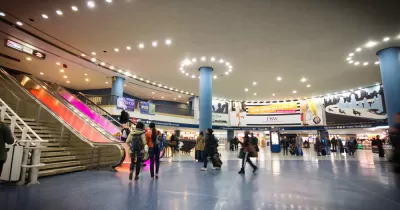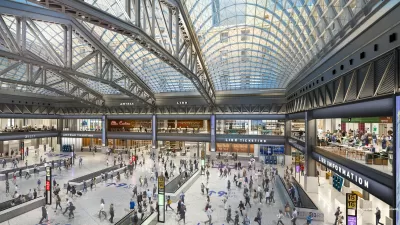Three days before America's busiest train station what will be two long months of repair work, dubbed "the summer of hell," the third derailment this year occurred, delaying most Amtrak and New Jersey Transit trains.

"None of the 180 passengers and crew members aboard the New Jersey Transit train that came off the tracks was injured, but the derailment underscored how hazardous the condition of the tracks there has become," report Patrick McGeehan and Elizabeth Tarbell for The New York Times.
The derailment occurred at a section where trains entering the station from a tunnel under the Hudson River are switched onto one of the 21 tracks leading to platforms beneath Penn Station’s main concourse. Officials of Amtrak, which owns and operates the station, have admitted that the junction, which is known as an interlocking, is long overdue for an overhaul.
A CBS This Morning 3:47-minute news video on the summer repair work at Penn Station includes narration by CBS News transportation correspondent Kris Van Cleave and Amtrak CEO Wick Moorman.
Moorman will stay on the job through the end of the year. On Wednesday, "Richard Anderson, who spearheaded Delta's growth into the world's largest airline by market value when he retired as chief executive in May 2016, will become president and co-CEO," according to Reuters.
McGeehan and Sarah Maslin Nir report on July 10 after the morning rush hour that "the first day of track closings and disruptions at New York’s Pennsylvania Station unfolded relatively smoothly on Monday, as riders detoured onto buses, ferries and subways."
The eight weeks of intensive repairs will reduce the station’s capacity during the morning and evening rush hours by more than 20 percent. The reduction forced Amtrak and the two commuter railroads that use Penn Station — the Long Island Rail Road and New Jersey Transit — to revise their schedules.
The July 6 derailment follows an April 3 NJ Transit derailment in the station and a minor Amtrak Acela derailment on March 24. Both were determined to be caused by track defects, emphasizing the need for the repair work.
FULL STORY: Penn Station Derailment Gives Stark Proof of Tracks’ Disrepair

Study: Maui’s Plan to Convert Vacation Rentals to Long-Term Housing Could Cause Nearly $1 Billion Economic Loss
The plan would reduce visitor accommodation by 25,% resulting in 1,900 jobs lost.

North Texas Transit Leaders Tout Benefits of TOD for Growing Region
At a summit focused on transit-oriented development, policymakers discussed how North Texas’ expanded light rail system can serve as a tool for economic growth.

Why Should We Subsidize Public Transportation?
Many public transit agencies face financial stress due to rising costs, declining fare revenue, and declining subsidies. Transit advocates must provide a strong business case for increasing public transit funding.

How to Make US Trains Faster
Changes to boarding platforms and a switch to electric trains could improve U.S. passenger rail service without the added cost of high-speed rail.

Columbia’s Revitalized ‘Loop’ Is a Hub for Local Entrepreneurs
A focus on small businesses is helping a commercial corridor in Columbia, Missouri thrive.

Invasive Insect Threatens Minnesota’s Ash Forests
The Emerald Ash Borer is a rapidly spreading invasive pest threatening Minnesota’s ash trees, and homeowners are encouraged to plant diverse replacement species, avoid moving ash firewood, and monitor for signs of infestation.
Urban Design for Planners 1: Software Tools
This six-course series explores essential urban design concepts using open source software and equips planners with the tools they need to participate fully in the urban design process.
Planning for Universal Design
Learn the tools for implementing Universal Design in planning regulations.
City of Santa Clarita
Ascent Environmental
Institute for Housing and Urban Development Studies (IHS)
City of Grandview
Harvard GSD Executive Education
Toledo-Lucas County Plan Commissions
Salt Lake City
NYU Wagner Graduate School of Public Service




























